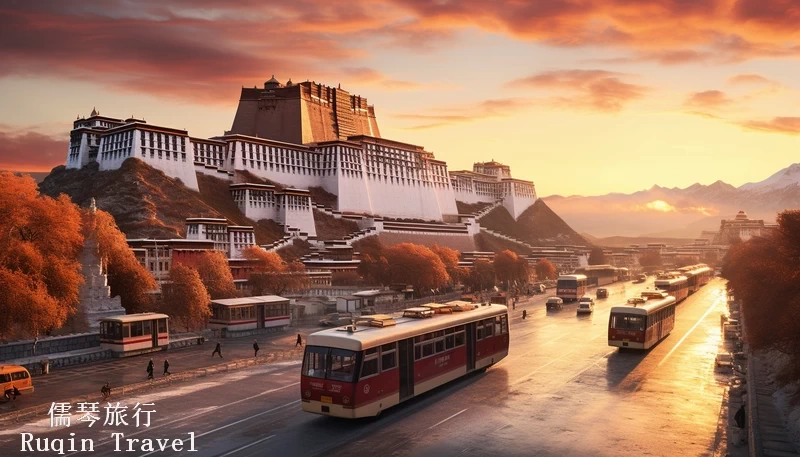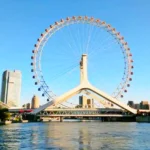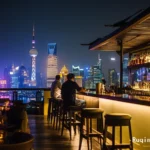Lhasa, the spiritual heart of Tibet, is a city of ancient monasteries, stunning landscapes, and rich cultural traditions. Located high in the Himalayas, it attracts visitors from around the world who seek to experience its unique heritage and breathtaking scenery. Planning a trip to Lhasa requires some preparation, but it is worth the effort. This guide will cover everything you need to know about how to visit Lhasa, from permits and transportation to cultural etiquette and top attractions.
Best Time to Visit Lhasa
When planning how to visit Lhasa, the timing of your trip is essential. The best time to visit Lhasa is during spring (April-June) and autumn (September-October). During these seasons, the weather is mild, with clear skies and pleasant temperatures. This makes it ideal for sightseeing and outdoor activities.
Summer (July-August) is also popular, but it can be rainy, especially in the afternoons. Despite the rain, summer is still a great time for visiting because of the lush, green scenery. Winter (November-March) is much colder, with temperatures dropping below freezing. However, the city is less crowded, and you can find lower travel costs. Choose your travel season based on your comfort with the weather and the activities you plan to do.
Do You Need a Special Permit to Visit Lhasa?
Yes, foreign tourists need a Tibet Travel Permit to visit Lhasa. This is in addition to a standard Chinese visa. You can only obtain the permit through a registered travel agency in China, as independent travel is not allowed for foreigners.
Your travel agency will arrange the permit as part of your tour package, so make sure to book your trip in advance. Additionally, if you plan to explore regions outside of Lhasa, such as Mount Everest Base Camp or Namtso Lake, you will need extra permits.
Organizing permits can take time, so start the process early to avoid delays. This is an important step in understanding how to visit Lhasa smoothly.
How Do I Get to Lhasa?
Lhasa is accessible by air, train, and road, but the journey requires planning. The most convenient way is to fly into Lhasa Gonggar Airport, with direct flights from major cities such as Beijing, Chengdu, Xian, and Kathmandu. Flights from Kathmandu offer a direct international route, making it an excellent option for those combining a Nepal and Tibet trip.
For a more scenic experience, consider taking the Qinghai-Tibet Railway. The train ride from Beijing to Lhasa takes about 40 hours, offering stunning views of the Tibetan Plateau. Trains also depart from other cities like Chengdu, Xining, and Shanghai. Though the journey is long, it provides a unique perspective of the landscapes leading to Lhasa.
How Many Days Should I Spend in Lhasa?
To fully enjoy the must-see attractions in Lhasa, plan to spend at least 3-4 days in the city. This duration allows you to visit key sites such as Potala Palace, Jokhang Temple, and Barkhor Street while giving you time to acclimate to the high altitude. Spend your first day taking it easy, as adjusting to the altitude is crucial.
If you have extra time, consider a longer stay of 6-7 days. This way, you can venture beyond Lhasa to places like Namtso Lake, Ganden Monastery, or even take a road trip to Gyantse and Shigatse. A longer visit also allows you to immerse yourself in Tibetan culture and traditions.
Is Altitude Sickness a Concern in Lhasa?
Altitude sickness is a common concern for visitors since Lhasa sits at an elevation of about 3,650 meters (12,000 feet). Symptoms can include headaches, dizziness, and shortness of breath. To minimize the effects, take it easy for the first couple of days. Drink plenty of water, avoid alcohol, and get plenty of rest.
Consider consulting your doctor about altitude medication before your trip. Most people acclimate within a few days, but it’s essential to listen to your body and seek medical help if symptoms worsen. Understanding how to manage altitude sickness is a crucial part of learning how to visit Lhasa safely.
The Must-See Attractions in Lhasa
Lhasa is home to some of the most iconic cultural and historical sites in Tibet. Here are the must-see attractions in Lhasa:
- Potala Palace: This UNESCO World Heritage site was once the winter residence of the Dalai Lama. It towers over the city, offering breathtaking views and insight into Tibetan history.
- Jokhang Temple: The spiritual center of Lhasa and the holiest temple in Tibet. It attracts pilgrims from all over the region who walk around the temple in prayer.
- Barkhor Street: A bustling market area surrounding Jokhang Temple. It’s perfect for exploring local shops, trying street food, and observing Tibetan culture.
- Sera Monastery: Famous for the lively debates held by monks in the afternoons. These debates are an engaging way to witness Tibetan Buddhist practices.
- Norbulingka: Known as the summer palace of the Dalai Lama, it features beautiful gardens and an opportunity to learn more about Tibetan culture.
Do I Need a Guide to Visit Lhasa?
Yes, foreign tourists are required to have a licensed guide when visiting Lhasa and other parts of Tibet. Independent travel is not permitted, so you must book a tour through a registered travel agency. Your guide will accompany you to major sites, help manage permits, and provide insight into Tibetan history and culture.
While some may prefer exploring solo, having a guide ensures compliance with local regulations. Plus, it enriches your understanding of the places you visit. The guide will also assist in navigating any language barriers, making your trip smoother and more enjoyable.
What Should I Pack for a Trip to Lhasa?
Packing smartly is essential for a comfortable trip. Here’s what you should bring:
- Layered clothing: Temperatures can vary throughout the day. Pack layers that you can adjust easily.
- Comfortable walking shoes: Many attractions require walking, so good shoes are a must.
- Sun protection: The sun is intense at high altitudes, so bring sunscreen, a hat, and sunglasses.
- Medications: Carry any altitude medication prescribed by your doctor and other general health essentials.
- Travel documents: Make sure you have your passport, Tibet Travel Permit, and copies of your travel documents.
Planning what to pack for a trip to Lhasa ensures that you’re prepared for different weather conditions and unexpected situations.
What Are the Cultural Etiquette Tips I Should Be Aware of in Lhasa?
Respect for local culture is crucial when visiting Lhasa. Here are some cultural etiquette tips to keep in mind:
- Dress modestly, especially when visiting temples and monasteries. Cover your shoulders and avoid wearing shorts.
- Do not photograph monks or religious ceremonies without asking for permission. Some sites have strict rules against photography.
- Always walk clockwise around temples and religious structures. This is a sign of respect.
- Avoid discussions on sensitive topics related to Tibetan politics. It is best to steer clear of controversial subjects during your visit.
Being aware of these customs will help you show respect for local traditions and ensure a smoother experience.
Can I Use Credit Cards in Lhasa?
While credit cards are accepted in larger hotels, upscale restaurants, and some shops, cash (Chinese yuan) remains the preferred method of payment, especially in local markets and smaller establishments. ATMs are available in Lhasa, but it’s advisable to carry enough cash, particularly if you plan to travel outside the city.
Mobile payment platforms like WeChat Pay and Alipay are popular in China, but they can be challenging for foreign tourists to set up without a local bank account. Make sure to have cash on hand to avoid any payment issues during your trip.
Is Lhasa Safe for Solo Travelers?
Yes, Lhasa is generally safe for solo travelers, including women. The city is well-patrolled, and locals are friendly and welcoming. However, remember that all foreign visitors must join a tour group, so even if you’re traveling solo, you’ll have a guide with you.
Basic safety precautions still apply, such as keeping your belongings secure and being aware of your surroundings. Following the guidance of your travel agency and guide will also ensure that you stay within the regulations.
How Do I Get Around Lhasa?
Most of Lhasa’s main attractions are within walking distance, making it easy to explore on foot. Taxis are available for longer trips, and they are affordable and convenient. Tour buses arranged by your travel agency are the best option for visiting places outside the city, such as Namtso Lake or Ganden Monastery.
Bike rentals are another option for those who want to explore the city at a slower pace. However, keep in mind that the high altitude can make cycling more challenging, so only attempt it if you are well-acclimated.
Can I Visit Lhasa on a Budget?
Traveling to Lhasa can be more expensive than other parts of China due to the permit requirements and the need for a guided tour. However, it is still possible to visit Lhasa on a budget. Opt for budget accommodations, join group tours rather than private ones, and dine at local eateries to save money.
Street food is affordable, and many of the best experiences, like exploring Barkhor Street or attending a monastic debate, are free. Planning your trip during the off-season (winter months) can also help you save on flights and tour packages.
Do I Need to Learn Tibetan to Visit Lhasa?
You do not need to learn Tibetan to visit Lhasa, but knowing a few basic phrases can make your trip more enjoyable. Mandarin Chinese is the main language, and many guides and staff at hotels speak some English. However, locals appreciate it when visitors make an effort to greet them in Tibetan, such as saying “Tashi Delek” (hello).
A translation app can be useful for quick translations, and your guide will help with any language barriers. Understanding a few phrases is a small effort that will earn you smiles and show respect for the local culture.
Final Thoughts on How to Visit Lhasa
Lhasa is a city of spiritual depth, striking landscapes, and welcoming people. Visiting this high-altitude city requires preparation, but the rewards are immense. By following this guide on how to visit Lhasa, you’ll be well-equipped to navigate the permits, cultural nuances, and travel logistics. With the right planning, your journey to Lhasa will be a memorable adventure that stays with you long after you leave.



